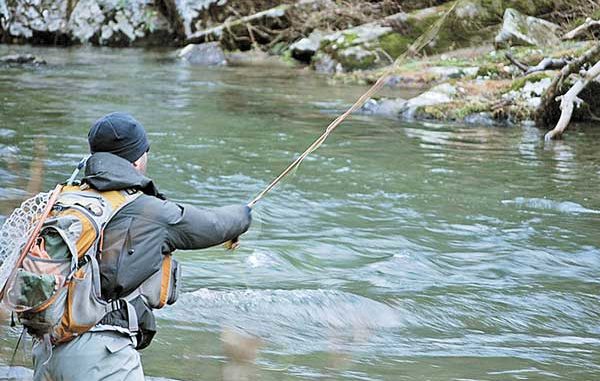
Fishing line gets a lot of wear during the course of a fishing day.
It’s dragged over sharp rocks, pulled along rough stream bottoms, snagged on submerged logs and other debris in the water and is constantly being stretched and pulled.
Even the best fishing lines are weakened by constant abrasion. You get a fast strike or hook a big fish, and, all of a sudden, you’re reeling in empty line.
A good rule to follow is to regularly check your line by running it between your thumb and forefinger — before you get in the water. If the line feels rough, keep checking until you find a smooth section and cut off the worn part. Put new line on your reels at the start of a new fishing season, and a couple of times during the season if you fish often.
Prolonged exposure to ultraviolet rays can weaken nylon monofilament, especially if line isn’t properly stored between fishing trips. To check for ultraviolet damage, run the line between your fingers and feel for dryness or brittleness. Check up the line until it shows normal condition and strength and cut off the damaged line. Store filled reels and extra line in a cool, dark space.
Properly getting loaded
To load line on a bait-casting reel, insert a pencil in the new spool and have someone hold the ends of the pencil while you crank line on the reel. Press against the sides of the supply spool to maintain pressure.
The key to putting fresh line on an open-face spinning reel is to avoid line twist.
Have someone hold the supply spool, or hang it on a wall nail or place it on the floor. Pull off a couple of yards of line, making sure it comes off the end of the spool in loops. Thread the line through the guides and tie it on the reel with the bail open. Hold the rod tip 3 to 4 feet away from the spool, reel on about 20 feet of line and stop. Move the rod tip to about one foot from the supply spool. If the line twists, turn the spool completely around to eliminate twist. Keep light tension on the line as you spool in by holding the line between the thumb and forefinger of your free hand.
To put line on a closed-face reel, follow the same procedure for a spinning reel, but make sure you unlatch the cover so you can see if you’re overfilling or underfilling the spool.
No more tangles
Put two fishing rods close together, turn your back, and they’ll be hopelessly snarled in a matter of seconds. You then spend precious fishing time trying to get the rods untangled.
When transporting rods, either in a vehicle or boat, secure the hook on the reel, grasp the line halfway down the rod, wrap it a couple of times around the rod, and loop the line over a guide. No more tangles.
Sometimes new line will tangle as you take it off the spool because of line-set from being on the spool too long.
Try soaking new line for an hour or so in warm tap water before putting it on your reel. The warm water will make the line much more manageable.
If the old line on your reel tangles, immerse the reel and line in warm tap water and let it soak for a couple of minutes.
Let’s don’t do the twist
When using a spinning lure, spoon or bait, attach a swivel to allow the lure to turn freely. If you get a twist in the end of the line, raise the rod tip and let the dangling lure or bait unwind the line.
If the twist is farther up the line, remove the lure or bait and let the current carry the line downstream and unwind the kinks.
If the line continues to twist no matter what you try, strip it off and put on new line.
Nests are for the birds
It’s happened to all of us. Line uncoils off the reel for no good reason and, before you know it, tangles into a handful of knotted line.
It’s enough to make you want to throw your rod and reel into the bushes.
Line filled too close to the lip of the spool often will loop off and become tangled. Spools shouldn’t be filled beyond 1/8 to 1/4 inch from the lip.
If line is too loosely wound on a reel, it also will loop off and get tangled. If this happens, make a long cast downwind or let the line out in a current and reel in the line.
Kind of a drag
Sometimes line will break because the reel’s drag is set improperly. The drag must be set loosely enough to let the fish take line off the reel as it makes its run, yet tight enough to slow down and tire the fish.
Most tackle manufacturers suggest setting the drag at no more than half the pound-test of the line.
When fishing in deep water or in heavy currents, set the drag at one-third of the line’s pound test.
Don’t live on the trashy side
Fishing line should never be discarded at stream banks or lake shores.
Nylon degrades slowly and tangles of line from stripped reels clutter fishing areas for years. Worse than being an eyesore, the line can be a lethal trap for birds and other wildlife.
Carry a litter bag with you and put discarded fishing line and other trash in it.




Be the first to comment